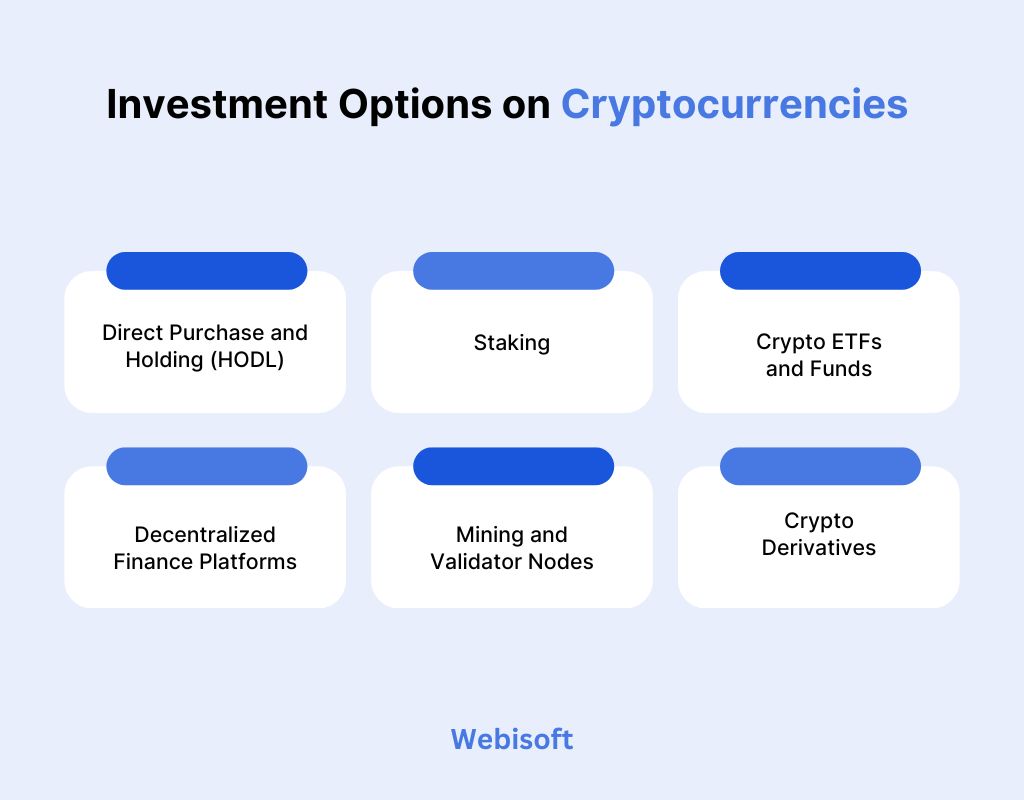The rapid rise of digital currencies has introduced both opportunity and confusion. Yet a fundamental question remains: how does cryptocurrency work in real-world financial systems?
Without technical clarity, professionals risk misjudging asset value, legal exposure, or market utility.
Cryptocurrency operates through decentralized, cryptographic networks that eliminate the need for intermediaries while enhancing transaction transparency.
This guide offers a comprehensive explanation to help investors understand cryptocurrency’s core mechanisms and practical implications.
Contents
- 1 What Is Cryptocurrency?
- 2 How Does Cryptocurrency Work?
- 3 How Are Cryptocurrencies Created?
- 4 Common Cryptocurrency examples
- 5 How To Choose And Buy The Right Cryptocurrency?
- 6 State-based Regulations on Cryptocurrency
- 7 What Are the Advantages And Limitations of Cryptocurrency?
- 8 Investment Options on Cryptocurrencies
- 9 Cryptocurrency vs. Traditional Currency
- 10 In Closing
- 11 Frequently Asked Questions
What Is Cryptocurrency?
Cryptocurrency is a digital asset designed to work as a medium of exchange. It uses cryptographic techniques to secure transactions and control the creation of new units.
The foundation of cryptocurrency lies in blockchain technology, a distributed ledger system that records every transaction across a network. This ensures transparency, prevents tampering, and removes the need for third-party verification.
Each cryptocurrency functions through a set of protocols that govern its supply, issuance, and security. Most are decentralized, meaning no single entity has control over the network.
The cryptocurrency meaning extends beyond digital money—it represents a shift in how value is stored and transferred. Institutions such as the Bank for International Settlements have closely studied its implications on global finance.
How Does Cryptocurrency Work?
Cryptocurrency works through a decentralized network of computers that maintains a shared digital ledger called the blockchain.
Every transaction is recorded, verified, and stored across multiple nodes, making the system transparent and tamper-resistant.
When someone sends cryptocurrency, the transaction is grouped into a block and broadcast to the network.
These blocks are validated using consensus mechanisms such as proof of work or proof of stake, depending on the cryptocurrency. Once verified, the block is added permanently to the chain.
Each transaction uses cryptographic keys—public for receiving and private for sending—to ensure secure and authorized transfers. Unlike traditional banking systems, there’s no need for intermediaries.
This structure allows for fast, global transfers with lower fees. Organizations like the European Central Bank have analyzed how this system could impact monetary policy and financial infrastructure.
How Are Cryptocurrencies Created?
Cryptocurrencies are created through processes defined by their underlying blockchain protocols. The most common method is mining, used by networks like Bitcoin.
In this system, powerful computers solve complex mathematical problems to validate transactions. As a reward, new coins are issued to the miner who solves the problem first.
This process is known as proof of work, and it requires substantial computing power and energy. It also ensures the security and integrity of the blockchain.
Other cryptocurrencies, such as Ethereum 2.0 and Cardano, use proof of stake, where new coins are minted based on the amount of currency a user holds and commits to the network. This approach is more energy-efficient and scalable.
Agencies like the U.S. Department of Energy have analyzed the environmental impact of crypto creation, especially in energy-intensive networks like Bitcoin.
Common Cryptocurrency examples
The crypto market includes thousands of coins, but only a few dominate in terms of usage, market value, and influence.
Below are ten key cryptocurrencies worth knowing:
- Bitcoin (BTC): The first cryptocurrency, Bitcoin uses proof of work and a fixed supply model. It’s widely adopted as digital gold and a store of value.
- Ethereum (ETH): Ethereum introduced smart contracts, enabling decentralized applications. It’s shifting to proof of stake and powers much of the DeFi and NFT ecosystem.
- Tether (USDT): USDT is a stablecoin pegged to the U.S. dollar. It’s used to reduce volatility and support liquidity across crypto exchanges and trading platforms.
- XRP (Ripple): Designed for fast, low-cost cross-border payments. Ripple Labs targets banks and financial institutions for global money transfers and settlement efficiency.
- BNB (Binance Coin): Originally launched to reduce trading fees on Binance, BNB now powers various applications, including decentralized exchanges, NFTs, and blockchain transaction fees.
- Solana (SOL): Solana is known for high-speed, low-cost transactions. It supports DeFi apps and smart contracts, leveraging a unique proof-of-history and proof-of-stake hybrid.
- Dogecoin (DOGE): Started as a meme, Dogecoin uses proof of work. Despite its origin, it’s gained attention for tipping, microtransactions, and strong community backing.
- USD Coin (USDC): USDC is a regulated, dollar-backed stablecoin issued by Circle. It offers transparency, liquidity, and compliance—used widely in DeFi and payment systems.
- Cardano (ADA): Cardano focuses on peer-reviewed development and academic research. It uses a proof-of-stake protocol and aims for a secure, scalable blockchain infrastructure for global use.
- TRON (TRX): TRON is built to decentralize content sharing and entertainment platforms. It processes high-volume transactions and supports smart contracts with low fees.
How To Choose And Buy The Right Cryptocurrency?

Buying cryptocurrency involves more than just picking a coin. It requires careful planning, secure platforms, and an understanding of how transactions and storage work.
Here’s a step-by-step guide.
Step 1: Choosing a reliable platform
Your first step is selecting a reputable cryptocurrency exchange or broker. Look for platforms with regulatory oversight, strong security features, transparent fee structures, and support for your preferred cryptocurrencies.
Popular choices include platforms regulated under financial authorities, such as those complying with the Financial Crimes Enforcement Network (FinCEN) or equivalent bodies.
A good platform should also offer user-friendly interfaces, liquidity, and reliable customer support. Before registering, confirm that the platform supports your local currency and withdrawal methods.
Review legal disclaimers and regional compliance, especially if you’re in jurisdictions with strict crypto laws. Trust and regulation are non-negotiable when choosing where to invest.
Step 2: Funding your account
Once you’ve chosen a platform, the next step is to deposit funds. Most exchanges allow funding via bank transfer, debit/credit cards, or third-party payment gateways.
Some platforms support stablecoins like USD Coin (USDC) for fiat-equivalent funding. Always check transaction fees, processing times, and limits before choosing a method.
For larger deposits, wire transfers may offer more favorable terms. If using crypto to fund your account, double-check the network compatibility (e.g., Ethereum vs. Binance Smart Chain) to avoid irreversible errors.
Follow platform-specific verification procedures to comply with Know Your Customer (KYC) regulations, which are legally required in most countries.
Step 3: Placing An Order
Once your account is funded, you can buy your chosen cryptocurrency. Most platforms offer different order types: market orders, limit orders, and stop orders.
A market order buys the asset immediately at the current price, while a limit order allows you to set a specific price. For beginners, market orders are the easiest but may incur slippage. Professionals often use limit orders for more control.
Before placing the order, review transaction fees, available balances, and price charts. After confirmation, the cryptocurrency will appear in your platform wallet. You can track your holdings and transaction history directly through the exchange dashboard.
Step 4: Decide on Storage
Once you’ve purchased cryptocurrency, secure storage becomes critical. Exchanges offer convenience, but they’re not ideal for long-term holding due to security risks.
Below are the main storage options to consider:
- Exchange Wallet: Provided by the trading platform. Convenient for short-term use but vulnerable to hacks and platform outages.
- Software Wallet: Installed on a desktop or mobile device. Good for daily use, but security depends on the device’s protection.
- Hardware Wallet: A Hardware Wallet is a physical device that stores private keys offline. Ideal for long-term storage and high-value assets.
- Paper Wallet: A physical printout of your private keys. Completely offline but must be stored securely to avoid loss or damage.
- Custodial Wallet: Managed by a third party. Easier for beginners but gives less control over your private keys.
State-based Regulations on Cryptocurrency
Cryptocurrency regulations vary widely across regions. While some governments embrace digital assets, others impose restrictions or outright bans. Understanding regional policies is essential for compliance and risk assessment.
United States
The U.S. lacks a unified federal crypto framework. Instead, agencies like the SEC, CFTC, and FinCEN regulate based on context—securities, commodities, or money services.
Some states, like New York, require a BitLicense for crypto businesses. Tax reporting is mandatory through the IRS, and KYC compliance is federally enforced.
Asia
Regulation across Asia is mixed. Japan recognizes cryptocurrencies as legal property and regulates exchanges through its Financial Services Agency.
In contrast, China has banned crypto trading and mining entirely. Singapore promotes a balanced approach via the Monetary Authority of Singapore, focusing on innovation with strong anti-money laundering (AML) oversight.
Europe
The European Union is implementing MiCA (Markets in Crypto-Assets Regulation) to standardize rules across member states.
MiCA focuses on consumer protection, stablecoin oversight, and AML enforcement.
Countries like Germany have integrated crypto into existing financial laws, while others await EU-wide clarity. The European Central Bank is also studying digital euro frameworks.
What Are the Advantages And Limitations of Cryptocurrency?
Cryptocurrency has reshaped the financial landscape with new efficiencies, but it also introduces distinct risks. A clear view of both its strengths and drawbacks is essential before making informed decisions.
| Advantages | Limitations |
| Decentralization reduces single points of failure | Regulatory uncertainty creates compliance risks |
| Borderless transactions enable global financial access | High volatility undermines its use as a stable currency |
| Lower fees for cross-border payments | Scalability issues limit transaction throughput |
| 24/7 trading availability with no market close | Lack of consumer protections for lost or stolen assets |
| Transparent blockchain records improve audibility | Cybersecurity threats, including exchange hacks |
| Ownership of private keys ensures user-controlled assets | Complex interfaces hinder adoption by non-technical users |
| Tokenization allows new asset classes to emerge | Environmental concerns tied to energy-intensive blockchains |
Investment Options on Cryptocurrencies

Investing in cryptocurrency involves more than just buying and holding. Each option carries different risk profiles, liquidity, and strategic use. Understanding your investment goals is key before entering the market.
1. Direct Purchase and Holding (HODL)
This is the most common approach: buy and hold cryptocurrency long-term, expecting its value to rise. It requires strong conviction in the asset and tolerance for volatility. Investors often hold major coins like Bitcoin or Ethereum in cold storage for added security.
2. Staking
Staking involves locking up cryptocurrencies like Ethereum or Cardano in a proof-of-stake network to earn passive rewards. It’s less resource-intensive than mining and helps secure the blockchain. However, it often requires lock-up periods and carries risks if token values drop during staking.
3. Crypto ETFs and Funds
Regulated financial products like Bitcoin ETFs or crypto mutual funds offer exposure without needing to manage wallets or private keys. These options are ideal for institutional or cautious retail investors. Availability depends on jurisdictional approval and the regulatory status of digital assets.
4. Decentralized Finance (DeFi) Platforms
DeFi platforms offer high-yield investment options like liquidity provision, lending, and yield farming. These are decentralized protocols, meaning they operate without intermediaries. While returns can be significant, DeFi carries smart contract risks and is typically unregulated.
5. Mining and Validator Nodes
Technical investors can participate by running mining rigs (proof of work) or validator nodes (proof of stake). This contributes to blockchain operations and earns rewards. However, it requires capital investment, technical know-how, and ongoing maintenance.
6. Crypto Derivatives
Advanced traders use crypto futures, options, or perpetual contracts to speculate on price movements or hedge risk. These tools are offered on specialized exchanges and involve leverage, making them high-risk and not suitable for beginners.
Cryptocurrency vs. Traditional Currency
While both are used to exchange value, cryptocurrencies, and traditional (fiat) currencies operate on fundamentally different systems. Understanding their distinctions is essential for evaluating risk, usability, and long-term viability.
| Aspect | Cryptocurrency | Traditional Currency |
| Control | Decentralized and governed by blockchain protocols | Issued and regulated by central banks and governments |
| Supply Mechanism | Often fixed or algorithmically controlled | Supply is managed through monetary policy |
| Transaction Speed | Typically faster, especially for international payments | Varies by country and network; international transfers can be slow |
| Transparency | Public blockchain records all transactions | Transactions are private; visibility requires legal or institutional access. |
| Accessibility | Global access to the internet and a digital wallet | Limited by banking infrastructure and regional financial systems |
| Legal Recognition | Accepted in some jurisdictions, restricted or banned in others | Legal tender is universally accepted in its country of issuance |
| Security | Cryptographically secured but subject to hacks, especially on exchanges | Protected by legal systems and banking regulations |
In Closing
Cryptocurrency is more than a financial trend—it represents a shift in how digital systems handle value, trust, and ownership. As adoption accelerates, so does the need for reliable, secure, and scalable blockchain solutions.
If your business is exploring crypto integration or blockchain infrastructure, Webisoft provides expert development services—from custom wallets to full-scale platforms and payment gateways.
Partner with Webisoft to build secure, future-ready solutions tailored to your digital asset strategy.
Frequently Asked Questions
Can cryptocurrency be used for everyday purchases?
Yes, some retailers and service providers accept cryptocurrency, especially Bitcoin. However, adoption varies by region, and transaction speed or volatility may affect its practicality.
Is cryptocurrency legal worldwide?
Legality varies. Some countries permit regulated use, others restrict it, and a few have banned it entirely. Always review local regulations before investing or transacting in crypto.
What is a smart contract in cryptocurrency?
A smart contract is a self-executing program stored on a blockchain. It automatically enforces conditions agreed upon by both parties, eliminating the need for intermediaries.
Are crypto transactions anonymous?
Not entirely. Most blockchains are pseudonymous—transactions are public but not directly linked to personal identities. Privacy-focused coins offer more anonymity but raise regulatory concerns.
How is cryptocurrency taxed?
Taxation depends on jurisdiction. In many countries, cryptocurrencies are treated as property, meaning gains are subject to capital gains tax. Always consult with a tax advisor.
